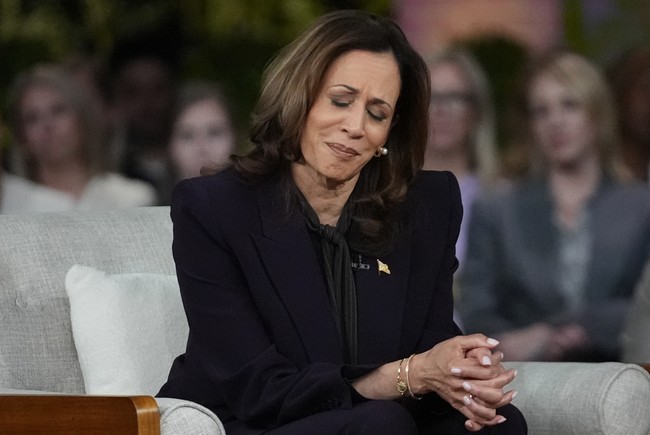
Kamala Harris graduated from Howard University without honors. Harris then applied to law school. She was admitted to Hastings School of Law at the University of California. Hastings is considered a good law school but not “elite.” It ranks 80th of America’s ABA schools.
Admission isn’t a “breeze” but it is pretty easy to be accepted for an honors student, with a solid LSAT. Of the total applicants to Hastings, about half are accepted and around a third of that number actually enroll. That means Hasting is a “backup” law school for a lot of the applicants.
She wasn’t an honors student at Howard. There is no information on what Kamala Harris scored on her LSAT. We do know that she didn’t pass the Bar on the first try when 80 percent of her classmates did pass. So how did a run-of-the-mill student, and daughter of a “privileged” upbringing get into Hastings School of Law?
Easy – she fudged her application. Harris was admitted under a program called LEOP. According to the University:
UC Hastings created the Legal Education Opportunity Program (LEOP) in 1969 to make an outstanding legal education accessible to those who come from disadvantaged economic and educational backgrounds.
Students are encouraged to submit a “separate LEOP statement describing the adversity they faced and its impact on their academic preparedness for law school. Diagnostic reports documenting disabilities and/or accommodations can be submitted as addenda.”
In a Politico article from 2021, the author describes Harris at Hastings:
In the fall of 1986, Harris arrived on campus at Hastings a week before most of her classmates. She was part of the pre-orientation Legal Education Opportunity Program (LEOP), which had been founded in 1969 to help law students from disadvantaged communities navigate the stringent demands of the first-year curriculum. Harris had come to a predominantly white institution after four years at a historically Black university. Beyond introducing students to Socratic pedagogy, case-briefing and exam-taking, the pre-orientation also gave students of color a sense of community and a hamlet of solidarity in a cut-throat environment.
Harris, the daughter of two college professors, who grew up attending private schools in Canada, was not, in the least, economically or socially disadvantaged. But there she is, claiming she was.
At the start of the program in the early 70s, new students admitted through LEOP did not fare well. The dropout rate was high, so the school instituted a more “hands-on” routine assigning one-on-one tutors to help navigate law school for LEOP students. On paper, the program wasn’t intended for one of her social position of privilege.
Harris was immersed in Indian culture growing up in Montreal. Her family traveled the world. Her mother was taken aback when a Head Start teacher was “shocked” that Harris wasn’t from the poor side of Oakland. Harris’s mother told him that Kamala was the daughter of privilege. Harris didn’t fit into the intended target demographic that LEOP was designed for – but she fully took advantage of her ethnic heritage. At least one side of it. Once admitted under the program Haris joined the BLSA (Black Law Students Association). Raised by her Indian mother, Harris found more currency in being black.
Students discovered that a bulletin board decorated by the Black Law Students Association (BLSA) to commemorate Black History Month had been vandalized with a racist marking: a grotesque caricature of a Black man with a “forbidden” sign slashing his face.
Harris told the Hasting newspaper that “It’s what we deal with all the time”. Apparently, no one was ever identified for the act of racism. 36 years ago, race hoaxes weren’t all the rage.
Although some of her fellow students talked about Harris’s “passion” none spoke of her intellect. One professor said that she was:
“very polite” and “reserved” demeanor, sitting to the far right of the very last row in the auditorium, listening intently but not saying much.
California attorney Laura Powell tracked down other information about Harris while Harris was at Hastings.
During Harris’s time at Hastings, she was, according to her resume, “president” of the BLSA and thus likely sat in judgment of who would get into Hastings via LEOP. Hasting’s dean found out that the committee that selected students was interviewing applicants. He said that he stopped the interview process because it became clear that it wasn’t accepting students based on need (or in Harris’s case a lack of need), but based on political leanings.
When he asked a selector about asking political questions He didn’t like the answer:
One student at the meeting said “well we don’t ask those questions; we likely would get Clarence Thomases”
That comment confirmed the Dean’s worst fears. The interview process was stopped but it was obvious that the program was left-leaning and biased.
To get into law school, Harris was a beneficiary of a program that wasn’t intended for someone of her economic or social status. She almost certainly lied on her application or at a minimum knew that her politics would fit with the LEOP selection committee. Harris was “waved in” because of a lie or because of politics. Harris has consistently used the “system” she decries, and she gained positions that she did not deserve and did not earn. She gamed the system.
Not very “equitable” of her, it seems.
Harris reminds me of “The Jerk” and this iconic line:
